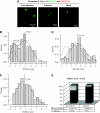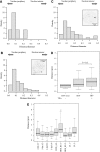Transcriptional competence of the integrated HIV-1 provirus at the nuclear periphery
- PMID: 19478796
- PMCID: PMC2726691
- DOI: 10.1038/emboj.2009.141
Transcriptional competence of the integrated HIV-1 provirus at the nuclear periphery
Abstract
Spatial distribution of genes within the nucleus contributes to transcriptional control, allowing optimal gene expression as well as constitutive or regulated gene repression. Human immunodeficiency virus type 1 (HIV-1) integrates into host chromatin to transcribe and replicate its genome. Lymphocytes harbouring a quiescent but inducible provirus are a challenge to viral eradication in infected patients undergoing antiviral therapy. Therefore, our understanding of the contribution of sub-nuclear positioning to viral transcription may also have far-reaching implications in the pathology of the infection. To gain an insight into the conformation of chromatin at the site of HIV-1 integration, we investigated lymphocytes carrying a single latent provirus. In the silenced state, the provirus was consistently found at the nuclear periphery, associated in trans with a pericentromeric region of chromosome 12 in a significant number of quiescent cells. After induction of the transcription, this association was lost, although the location of the transcribing provirus remained peripheral. These results, extended to several other cell clones, unveil a novel mechanism of transcriptional silencing involved in HIV-1 post-transcriptional latency and reinforce the notion that gene transcription may also occur at the nuclear periphery.
Conflict of interest statement
The authors declare that they have no conflict of interest.
Figures







Comment in
-
Gene activation at the edge of the nucleus.EMBO J. 2009 Aug 5;28(15):2145-6. doi: 10.1038/emboj.2009.148. EMBO J. 2009. PMID: 19654603 Free PMC article. No abstract available.
Similar articles
-
Nuclear positional control of HIV transcription in 4D.Nucleus. 2010 Jan-Feb;1(1):8-11. doi: 10.4161/nucl.1.1.10136. Nucleus. 2010. PMID: 21327098 Free PMC article.
-
HIV Provirus Stably Reproduces Parental Latent and Induced Transcription Phenotypes Regardless of the Chromosomal Integration Site.J Virol. 2016 May 12;90(11):5302-14. doi: 10.1128/JVI.02842-15. Print 2016 Jun 1. J Virol. 2016. PMID: 26984732 Free PMC article.
-
Proviruses with Long-Term Stable Expression Accumulate in Transcriptionally Active Chromatin Close to the Gene Regulatory Elements: Comparison of ASLV-, HIV- and MLV-Derived Vectors.Viruses. 2018 Mar 8;10(3):116. doi: 10.3390/v10030116. Viruses. 2018. PMID: 29517993 Free PMC article.
-
Impact of chromatin on HIV-1 latency: a multi-dimensional perspective.Epigenetics Chromatin. 2025 Mar 8;18(1):9. doi: 10.1186/s13072-025-00573-x. Epigenetics Chromatin. 2025. PMID: 40055755 Free PMC article. Review.
-
Factors controlling chromatin organization and nucleosome positioning for establishment and maintenance of HIV latency.Curr HIV Res. 2008 Jun;6(4):286-95. doi: 10.2174/157016208785132563. Curr HIV Res. 2008. PMID: 18691027 Review.
Cited by
-
Insight in HIV Integration Site Selection Provides a Block-and-Lock Strategy for a Functional Cure of HIV Infection.Viruses. 2018 Dec 26;11(1):12. doi: 10.3390/v11010012. Viruses. 2018. PMID: 30587760 Free PMC article. Review.
-
Matrin 3 is a co-factor for HIV-1 Rev in regulating post-transcriptional viral gene expression.Retrovirology. 2011 Jul 20;8:61. doi: 10.1186/1742-4690-8-61. Retrovirology. 2011. PMID: 21771347 Free PMC article.
-
Expansion microscopy allows high resolution single cell analysis of epigenetic readers.Nucleic Acids Res. 2022 Sep 23;50(17):e100. doi: 10.1093/nar/gkac521. Nucleic Acids Res. 2022. PMID: 35716125 Free PMC article.
-
Higher-Order Chromatin Structures of Chromosomally Integrated HHV-6A Predict Integration Sites.Front Cell Infect Microbiol. 2021 Feb 26;11:612656. doi: 10.3389/fcimb.2021.612656. eCollection 2021. Front Cell Infect Microbiol. 2021. PMID: 33718266 Free PMC article.
-
Activation of HIV-1 proviruses increases downstream chromatin accessibility.iScience. 2022 Nov 8;25(12):105490. doi: 10.1016/j.isci.2022.105490. eCollection 2022 Dec 22. iScience. 2022. PMID: 36505924 Free PMC article.
References
-
- Andrulis ED, Neiman AM, Zappulla DC, Sternglanz R (1998) Perinuclear localization of chromatin facilitates transcriptional silencing. Nature 394: 592–595 - PubMed
Publication types
MeSH terms
Substances
LinkOut - more resources
Full Text Sources

